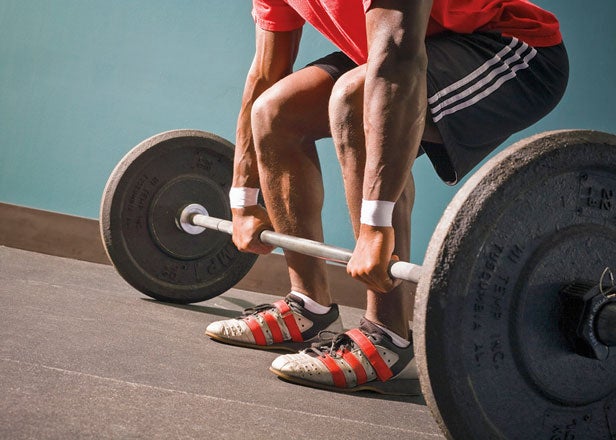THE MOST IMPRESSIVE feat of strength I've ever witnessed—besides the time my girlfriend twisted the cap off the jelly jar when I couldn't—was performed at a class in a small Salt Lake City gym by David Banks, a 38-year-old, 149-pound professional rock climber who dead-lifted nearly three times his body weight before my eyes.
Don't you have to be built like a Ukrainian power lifter to do that? Apparently not. That startling feat led to my first epiphany about strength training: that power and size don't always, or even often, correlate, and that developing strength pays huge dividends for athletes of almost any stripe.
“Most endurance athletes are weak,” says Joe Vigil, 80, a storied running coach in Mammoth Lakes, California, and author of the training book Road to the Top. “The closer you can come to a 100 percent effort in your training, the more pure strength you're going to develop for your game.”
Like a lot of people, I always assumed that weight lifting meant I would get bigger and that the extra mass would penalize me in any kind of endurance activity. But strength, as Vigil explained, has less to do with muscle size than what he calls “neural enervation”—that is, the brain's ability to turn on muscle fibers when they're asked to exert force.
Untrained muscle tissue recruits only about a third of its available fibers, says Vigil. By exposing muscles to heavier loads or higher-intensity exercises, however, you train them to tap into more of the muscle you already have. Even more compelling is the fact that, depending on your fitness goals, you may need to go heavy on the weights as little as once or twice a year for a few weeks in order to realize lasting improvement.
Inspired by my untapped potential, not to mention Banks's Mighty Mouse impersonation, I set up a monthlong DIY program, focusing on Vigil's “big three” exercises for athletes: the back squat, bench press, and dead lift. I spent the first two weeks simply rehearsing, until I could do 20 unweighted reps with perfect form, before adding weight.
Respectable targets for men like me who want to max out look something like this: bench your body weight, back-squat 1.5 times your body weight, and dead-lift twice your body weight. Since I'm a 190-pound “legs and lungs” athlete (my main sports are cycling, skiing, and soccer), the first time I tried to dead-lift any significant load, I was sure that my arms were going to tear from their sockets and I was going to hose down the gym in spurting torrents of blood. It was clear that, while I'd spent years working on my motor, I'd completely neglected my boat.
The strength came quickly, though. After a couple of weeks I maxed out at 170 pounds on the bench, 210 in the back squat, and an even 320 in the dead lift. Even though I was stronger, my body weight was the same.
In the weeks after my max effort, I phased into exercises with less weight but a higher intensity—box jumps, for example, instead of back squats—because those routines more closely mirror the sports I enjoy. But the strength from heavy lifting transferred over, allowing me to perform certain moves, like jumping or sprinting, longer and faster.
“For the average person, a gym or a weight room is one of the simplest and best ways to get stronger fast,” says Vigil, who still lifts four times a week. “It's something they should be doing all their lives.”
GO BIG
To harness your muscles' latent power, slip this maximum-effort gym session into your strength routine once every three to four months.
(1) 10–20 minutes easy aerobic warm-up
(2) Pick an appropriate lift for your sport, like the dead lift, bench press, or back squat. Estimate the maximum weight you think you can lift once with proper form, then do:
(a) 10 reps at 35 percentof your estimated max (EM)
(b) 5 reps at 55–60 percent of your EM
(c) 2 reps at 70–75 percent of your EM
(d) 1 rep at 85 percent EM
(e) 1 rep at 95 percent EM
(3) Do one rep of your max. If you get it and think you can go higher, try a small increase. If you can't get it, reduce weight slightly until you can complete the move. Always end on a successful lift—and always use a spotter.


